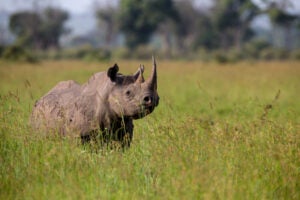
BRUSSELS— The European Commission today adopted the revised EU Action Plan against Wildlife Trafficking, a few days before the 19th Conference of the Parties for CITES (the Convention on International Trade in Endangered Species) kicks off in Panama. The new Action Plan recognises the role played by the EU in wildlife trafficking as an important destination market and a transit hub for the unsustainable legal and illegal wildlife trade; the latter is believed to have generated at least EUR 4.7 million in 2019.
The revised EU Action Plan against Wildlife Trafficking includes many laudable commitments to prevent the scourge of wildlife trafficking and address its root causes, as well as to bolster the EU’s legal and policy framework, improve enforcement and strengthen global partnerships to combat the the illegal trade in source, consumer and transit countries. In the wake of the COVID-19 pandemic, the report notably includes a consideration of the risk of zoonotic disease transmission via the wildlife trade and the need to follow a “One Health” approach in its regulation.
Dr Joanna Swabe, senior director of public affairs at Humane Society International/Europe, says:
“It is fantastic to see that the European Commission is taking concrete policy action to address civil society’s concerns about the EU’s failures to comprehensively tackle both the legal and illegal trade in wildlife. We are delighted that the Action Plan includes a commitment to looking at the development of new tools to tackle the issue of ‘stolen wildlife.’ For many years, we have been calling on the Commission to close the loopholes in the existing legislation by criminalising the trade in illegally sourced wildlife for the exotic pet trade, which is decimating imperiled species, particularly reptiles and amphibians, such as glass frogs, in other parts of the globe.”
She adds: “We also welcome that the Commission intends to apply greater scrutiny to imports of hunting trophies and be more transparent about decision-making concerning country-species combinations for trophy imports. While a comprehensive ban on trophy hunting imports would certainly have been preferable, the very least that the EU can do is to ensure that import permits are required for all trophies from threatened and endangered species.”
The Commission is also seeking to strengthen the engagement of local communities in the management and conservation of wildlife to support the development of sustainable livelihoods in source countries. Regrettably, it misguidedly lists “well-managed trophy hunting” as a form of sustainable income.
Dr. Swabe clarifies: “The claim that trophy hunting is well-managed is highly contentious. There is a long history of a lack of proper regulation of oversight when it comes to trophy hunting. Even where trophy hunting is legal and follows management guidelines, there is evidence of population declines, indirect negative effects on populations, biologically unsustainable quotas, offtake of restricted individuals like breeding females and cubs, poor population estimates and monitoring, quotas assigned at the incorrect spatial scale, and a lack of transparency. The regulations are insufficient in ensuring populations are not negatively impacted. Studies also find that trophy hunting does not provide meaningful employment opportunities or revenues for the majority of community members, and can instead contribute to wealth inequalities. Community-based natural resource management approaches should not make the poor poorer and the rich richer.”
The EU is well-placed to demonstrate global leadership in the fight against wildlife trafficking by ensuring strict regulation of wildlife trade and their effective enforcement. The question is whether the EU will live up to this leadership role in the upcoming CITES meeting (which begins on November 15), given its failure thus far to support the hippo, glass frogs and other proposals.
FACTS:
- HSI/Europe’s feedback on the roadmap for the revision of the action plan, which outlines HSI/Europe’s position on the import of hunting trophies and the need to close the loopholes in the EU Wildlife Trade Regulations, can be found here.
- The EU is the second-largest importer of animal trophies in the world, according to HSI/Europe’s report. Since 2016, the EU is the largest importer of lion trophies globally. Trophies from at least 15,000 internationally protected mammals from 73 CITES-listed species have been legally imported to the EU during the period 2014-2018 and there has been an increase of nearly 40% of trophy imports during this period.
- At present, the EU legal requirement for hunting trophies to be accompanied by import permits relates only to species in Annex A of the EU Wildlife Trade Regulation and six additional species listed in Annex B, namely the African elephant, common hippopotamus, African lion, southern white rhinoceros, polar bear and Argali sheep.
- Legally obtained hunting trophies of the species covered by these rules can only be imported into the EU after a Member State has issued an import permit and verified that such imports have been legally acquired and will not be detrimental to the conservation of the species. There is no transparent process for the issuance of such permits and non-detriment findings. Hunting trophies of all other species are exempted from this rule.
- With respect to the need to close the loopholes in the EU Wildlife Trade Regulations, the CITES does not cover all illegal wildlife trade. Many threatened species are protected from exploitation in their home countries but are not protected from being traded, either through domestic legislation or by CITES, and such domestic protections are often poorly enforced. In addition, many demand-focused countries have no protections for non-native species. As a result, wildlife traffickers are able to easily smuggle these animals into legal (or illegal) international trade flows, and once out of their countries of origin, little can be done to stop the trade in these species.
- Many demand-focused countries have no protections for non-native species. As a result, wildlife traffickers can easily smuggle these animals into legal—or illegal—international trade flows, and once out of their countries of origin, little can be done to stop the trade in these species. HSI/Europe is urging the EU to adopt supplementary legislation prohibiting the importation, transshipment, purchase and sale of wildlife taken illegally in the country of origin.
ENDS
Media contact: Yavor Gechev, Humane Society International/Europe: ygechev@hsi.org; +359889468098



